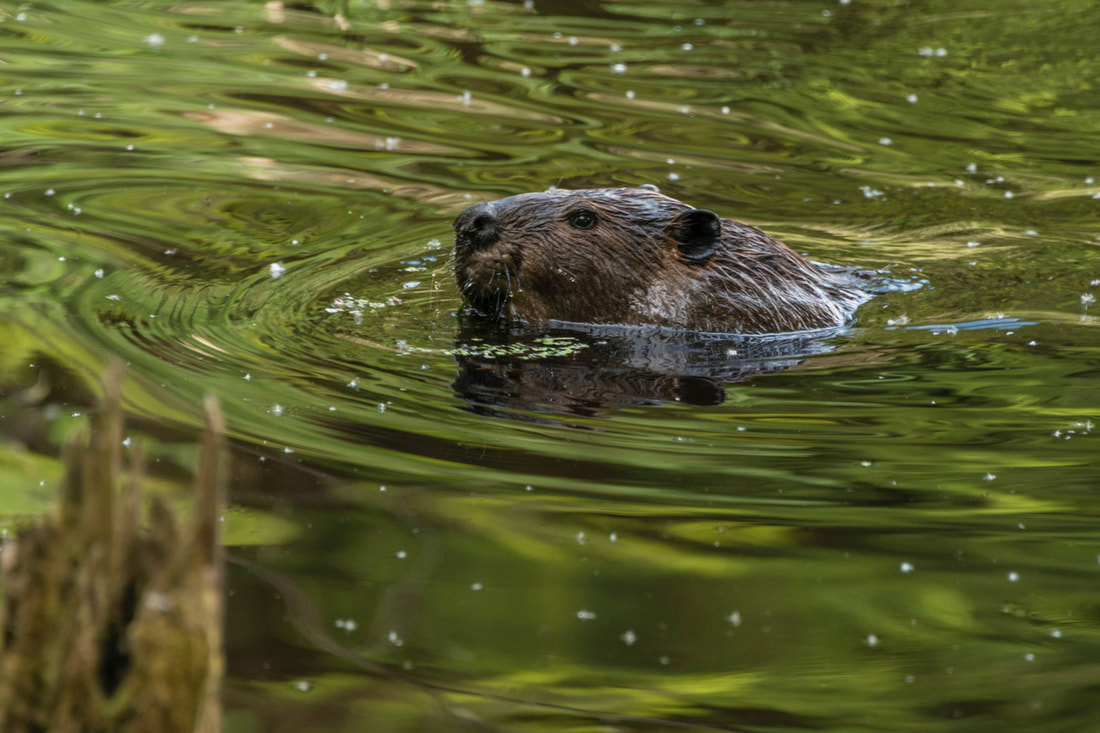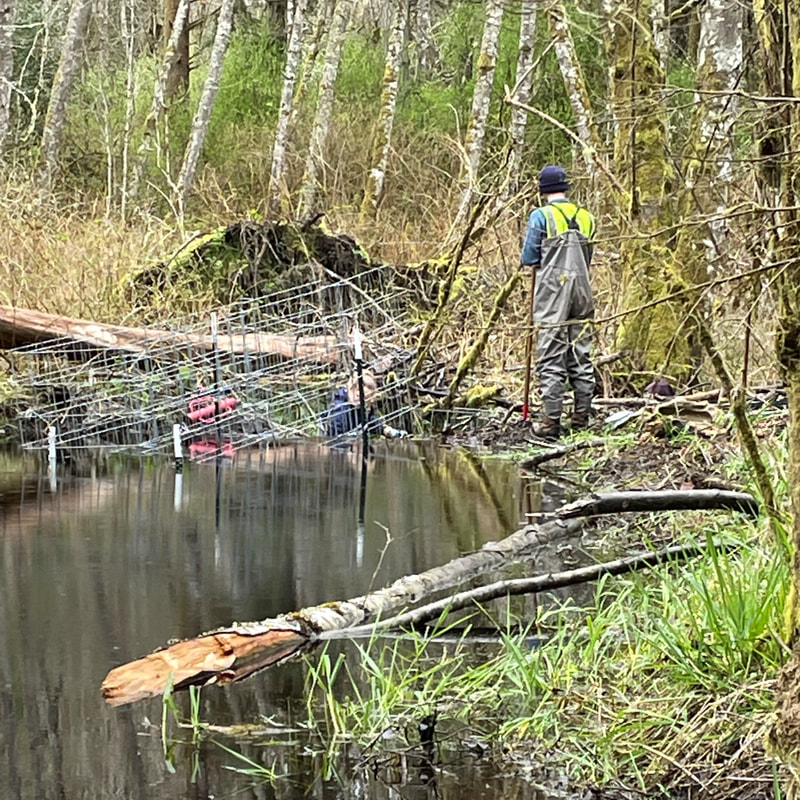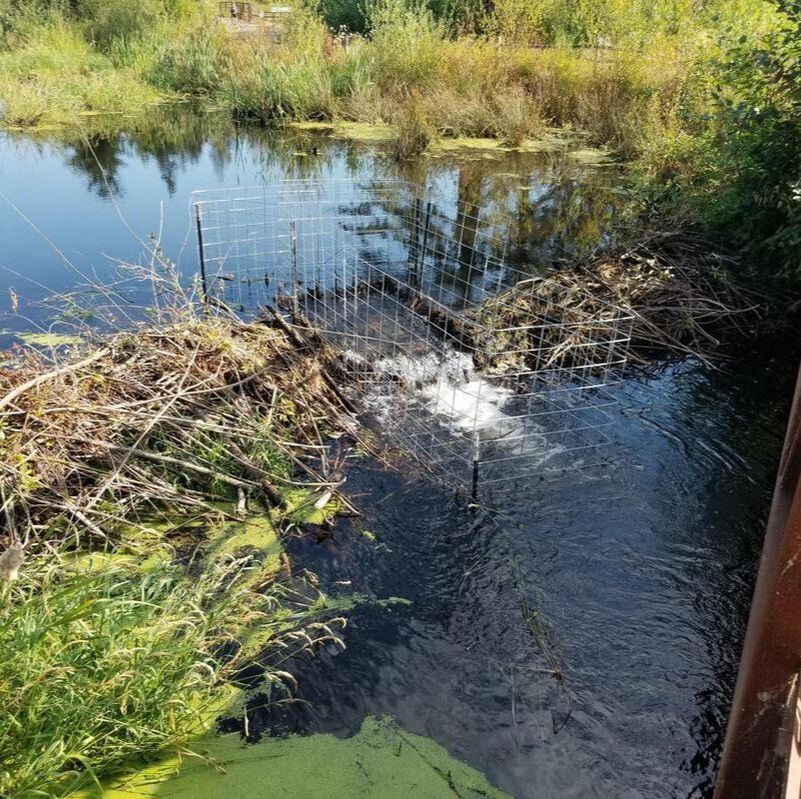Beaver-friendly solutions to mitigate dam-related flooding: Carpenter & Clear Creek
In November 2021, I wrote an article about beavers causing road flooding on Barber Cut Off Rd in Kingston and the County’s interest in finding longer term solutions than removing the beavers or their dams. Experts with Beavers Northwest, a non-profit that specializes in solutions that leave beavers in place, were consulted with the blessing of landowners, the County, and WDFW.
Beavers are called ‘ecosystem engineers’ because they, like humans, have a talent for shaping their environment to suit their needs. Beavers dam creeks to create ponds that allow them to forage on plants in the surrounding woodlands without leaving the safety of the water. They need to fell trees not just to build dams and lodges (their homes), but to access their most reliable food sources: twigs, leaves, bark, and the green layer just under the bark (cambium) of deciduous trees like alder, willow, maple and black cherry.
Keeping as many beavers as possible on Kitsap streams is not just good for the beavers. Beaver ponds store winter rains and release the water gradually, providing year-round wetland and stream habitat for juvenile coho and other wildlife despite our dry summers. They also allow more water to seep into the ground to recharge aquifers that Kitsap residents rely on for our household water supplies.
Beavers Northwest obtained the necessary permits and implemented their solution on March 28, 2022. After cutting away a small section of dam (“notching”) to allow more water to run out, they installed an elaborate, multi-layered “notch exclusion fence” above and around this area to prevent the beavers from repairing the damage. This lowered and stabilized the water to a level that allowed both beavers and people to go about their business during this long rainy spring and should continue to do so this winter.
Success on Carpenter Creek spurred Kitsap County Public Works to explore similar solutions in Silverdale. Beavers in the Clear Creek basin have responded to the 2016 flood plain restoration there too enthusiastically in places, flooding pedestrian trails. The County received a Hydraulic Project Approval from WDFW and on July 27, notched one dam, installed a notch exclusion fence, and removed an extension of the dam that beavers had constructed along the trail. The public is welcome to view this solution from the Clear Creek Loop Trail, as opposed to the Carpenter Creek dam and fence which is on private property.
Also, Kitsap County Public Works is hosting two Beaver Walks at Clear Creek in September - click here for more information and to register.
Beavers can be challenging for their human neighbors. However, disturbing beaver dams without a permit is illegal because beaver-created wetlands and late summer stream flows are vital for salmon in our region. To learn how to solve beaver issues affecting your property, please contact your regional WDFW office (https://wdfw.wa.gov/about/regional-offices) or Beavers Northwest (http://www.beaversnw.org/). Visit our Beaver page here for more information.
Beavers are called ‘ecosystem engineers’ because they, like humans, have a talent for shaping their environment to suit their needs. Beavers dam creeks to create ponds that allow them to forage on plants in the surrounding woodlands without leaving the safety of the water. They need to fell trees not just to build dams and lodges (their homes), but to access their most reliable food sources: twigs, leaves, bark, and the green layer just under the bark (cambium) of deciduous trees like alder, willow, maple and black cherry.
Keeping as many beavers as possible on Kitsap streams is not just good for the beavers. Beaver ponds store winter rains and release the water gradually, providing year-round wetland and stream habitat for juvenile coho and other wildlife despite our dry summers. They also allow more water to seep into the ground to recharge aquifers that Kitsap residents rely on for our household water supplies.
Beavers Northwest obtained the necessary permits and implemented their solution on March 28, 2022. After cutting away a small section of dam (“notching”) to allow more water to run out, they installed an elaborate, multi-layered “notch exclusion fence” above and around this area to prevent the beavers from repairing the damage. This lowered and stabilized the water to a level that allowed both beavers and people to go about their business during this long rainy spring and should continue to do so this winter.
Success on Carpenter Creek spurred Kitsap County Public Works to explore similar solutions in Silverdale. Beavers in the Clear Creek basin have responded to the 2016 flood plain restoration there too enthusiastically in places, flooding pedestrian trails. The County received a Hydraulic Project Approval from WDFW and on July 27, notched one dam, installed a notch exclusion fence, and removed an extension of the dam that beavers had constructed along the trail. The public is welcome to view this solution from the Clear Creek Loop Trail, as opposed to the Carpenter Creek dam and fence which is on private property.
Also, Kitsap County Public Works is hosting two Beaver Walks at Clear Creek in September - click here for more information and to register.
Beavers can be challenging for their human neighbors. However, disturbing beaver dams without a permit is illegal because beaver-created wetlands and late summer stream flows are vital for salmon in our region. To learn how to solve beaver issues affecting your property, please contact your regional WDFW office (https://wdfw.wa.gov/about/regional-offices) or Beavers Northwest (http://www.beaversnw.org/). Visit our Beaver page here for more information.
|
Beavers Northwest crew installing a complicated, multi-layer "notch exclusion fence" to discourage beavers from repairing a notch in their dam. The notch is sufficient to lower the pond water level and alleviate flooding while allowing the beavers to still have the habitat they need.
|
A single-layer notch exclusion fence on Clear Creek in Silverdale installed by Kitsap County Public Works on July 27, 2022. This site is easily viewed by the public from the pedestrian bridge on the right, as are other dams from the Clear Creek Trail.
|




